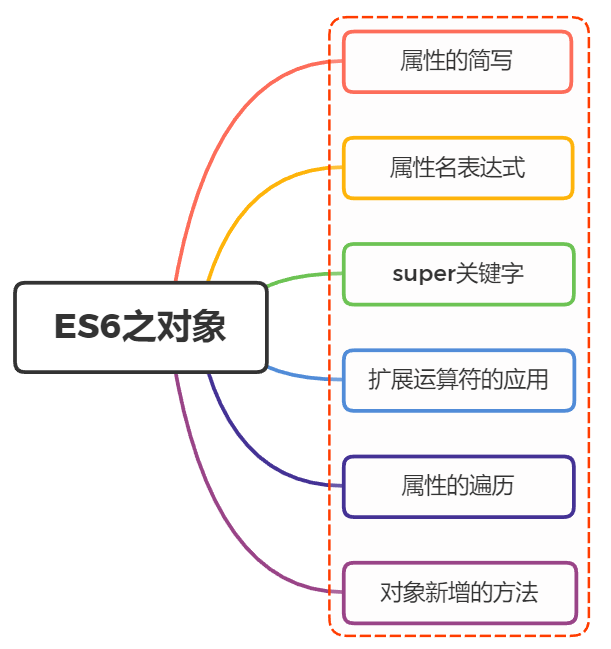面试官:对象新增了哪些扩展?

一、属性的简写
ES6中,当对象键名与对应值名相等的时候,可以进行简写
js
const baz = {foo:foo}
// 等同于
const baz = {foo}
方法也能够进行简写
js
const o = {
method() {
return "Hello!";
}
};
// 等同于
const o = {
method: function() {
return "Hello!";
}
}
在函数内作为返回值,也会变得方便很多
js
function getPoint() {
const x = 1;
const y = 10;
return {x, y};
}
getPoint()
// {x:1, y:10}
注意:简写的对象方法不能用作构造函数,否则会报错
js
const obj = {
f() {
this.foo = 'bar';
}
};
new obj.f() // 报错
二、属性名表达式
ES6 允许字面量定义对象时,将表达式放在括号内
js
let lastWord = 'last word';
const a = {
'first word': 'hello',
[lastWord]: 'world'
};
a['first word'] // "hello"
a[lastWord] // "world"
a['last word'] // "world"
表达式还可以用于定义方法名
js
let obj = {
['h' + 'ello']() {
return 'hi';
}
};
obj.hello() // hi
注意,属性名表达式与简洁表示法,不能同时使用,会报错
js
// 报错
const foo = 'bar';
const bar = 'abc';
const baz = { [foo] };
// 正确
const foo = 'bar';
const baz = { [foo]: 'abc'};
注意,属性名表达式如果是一个对象,默认情况下会自动将对象转为字符串[object Object]
js
const keyA = {a: 1};
const keyB = {b: 2};
const myObject = {
[keyA]: 'valueA',
[keyB]: 'valueB'
};
myObject // Object {[object Object]: "valueB"}
三、super关键字
this关键字总是指向函数所在的当前对象,ES6 又新增了另一个类似的关键字super,指向当前对象的原型对象
javascript
const proto = {
foo: 'hello'
};
const obj = {
foo: 'world',
find() {
return super.foo;
}
};
Object.setPrototypeOf(obj, proto); // 为obj设置原型对象
obj.find() // "hello"
四、扩展运算符的应用
在解构赋值中,未被读取的可遍历的属性,分配到指定的对象上面
js
let { x, y, ...z } = { x: 1, y: 2, a: 3, b: 4 };
x // 1
y // 2
z // { a: 3, b: 4 }
注意:解构赋值必须是最后一个参数,否则会报错
解构赋值是浅拷贝
js
let obj = { a: { b: 1 } };
let { ...x } = obj;
obj.a.b = 2; // 修改obj里面a属性中键值
x.a.b // 2,影响到了结构出来x的值
对象的扩展运算符等同于使用Object.assign()方法
五、属性的遍历
ES6 一共有 5 种方法可以遍历对象的属性。
for...in:循环遍历对象自身的和继承的可枚举属性(不含 Symbol 属性)
Object.keys(obj):返回一个数组,包括对象自身的(不含继承的)所有可枚举属性(不含 Symbol 属性)的键名
Object.getOwnPropertyNames(obj):回一个数组,包含对象自身的所有属性(不含 Symbol 属性,但是包括不可枚举属性)的键名
Object.getOwnPropertySymbols(obj):返回一个数组,包含对象自身的所有 Symbol 属性的键名
Reflect.ownKeys(obj):返回一个数组,包含对象自身的(不含继承的)所有键名,不管键名是 Symbol 或字符串,也不管是否可枚举
上述遍历,都遵守同样的属性遍历的次序规则:
- 首先遍历所有数值键,按照数值升序排列
- 其次遍历所有字符串键,按照加入时间升序排列
- 最后遍历所有 Symbol 键,按照加入时间升序排
js
Reflect.ownKeys({ [Symbol()]:0, b:0, 10:0, 2:0, a:0 })
// ['2', '10', 'b', 'a', Symbol()]
六、对象新增的方法
关于对象新增的方法,分别有以下:
- Object.is()
- Object.assign()
- Object.getOwnPropertyDescriptors()
- Object.setPrototypeOf(),Object.getPrototypeOf()
- Object.keys(),Object.values(),Object.entries()
- Object.fromEntries()
Object.is()
严格判断两个值是否相等,与严格比较运算符(===)的行为基本一致,不同之处只有两个:一是+0不等于-0,二是NaN等于自身
js
+0 === -0 //true
NaN === NaN // false
Object.is(+0, -0) // false
Object.is(NaN, NaN) // true
Object.assign()
Object.assign()方法用于对象的合并,将源对象source的所有可枚举属性,复制到目标对象target
Object.assign()方法的第一个参数是目标对象,后面的参数都是源对象
javascript
const target = { a: 1, b: 1 };
const source1 = { b: 2, c: 2 };
const source2 = { c: 3 };
Object.assign(target, source1, source2);
target // {a:1, b:2, c:3}
注意:Object.assign()方法是浅拷贝,遇到同名属性会进行替换
Object.getOwnPropertyDescriptors()
返回指定对象所有自身属性(非继承属性)的描述对象
js
const obj = {
foo: 123,
get bar() { return 'abc' }
};
Object.getOwnPropertyDescriptors(obj)
// { foo:
// { value: 123,
// writable: true,
// enumerable: true,
// configurable: true },
// bar:
// { get: [Function: get bar],
// set: undefined,
// enumerable: true,
// configurable: true } }
Object.setPrototypeOf()
Object.setPrototypeOf方法用来设置一个对象的原型对象
js
Object.setPrototypeOf(object, prototype)
// 用法
const o = Object.setPrototypeOf({}, null);
Object.getPrototypeOf()
用于读取一个对象的原型对象
js
Object.getPrototypeOf(obj);
Object.keys()
返回自身的(不含继承的)所有可遍历(enumerable)属性的键名的数组
js
var obj = { foo: 'bar', baz: 42 };
Object.keys(obj)
// ["foo", "baz"]
Object.values()
返回自身的(不含继承的)所有可遍历(enumerable)属性的键对应值的数组
js
const obj = { foo: 'bar', baz: 42 };
Object.values(obj)
// ["bar", 42]
Object.entries()
返回一个对象自身的(不含继承的)所有可遍历(enumerable)属性的键值对的数组
js
const obj = { foo: 'bar', baz: 42 };
Object.entries(obj)
// [ ["foo", "bar"], ["baz", 42] ]
Object.fromEntries()
用于将一个键值对数组转为对象
js
Object.fromEntries([
['foo', 'bar'],
['baz', 42]
])
// { foo: "bar", baz: 42 }
 Web Interview
Web Interview